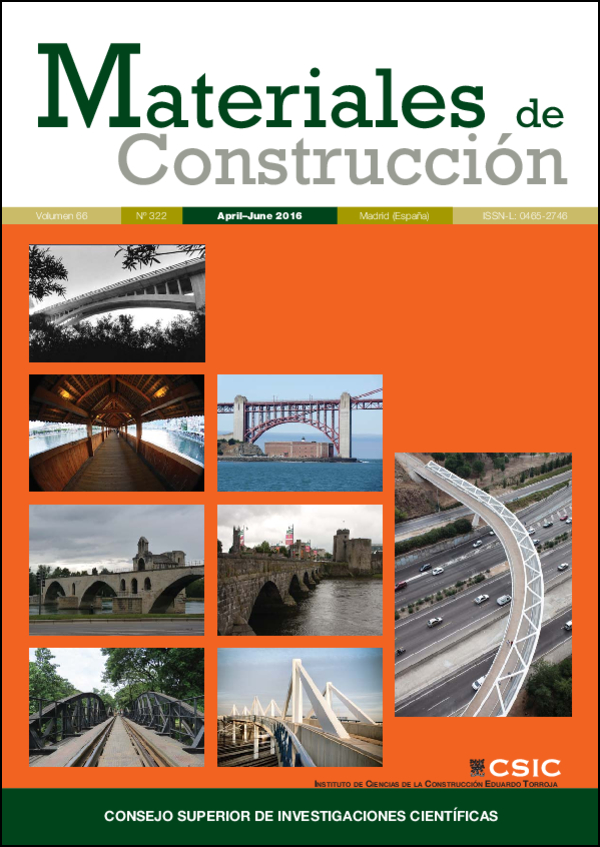Efecto de puzolanas con características físicas y químicas diferentes sobre las propiedades del hormigón
DOI:
https://doi.org/10.3989/mc.2016.01815Palabras clave:
Hormigón, Metacaolín, Puzolanas, Durabilidad, Propiedades físicasResumen
La durabilidad de las estructuras de hormigón es un tema importante hoy en día. En concreto, en el caso de los puentes de hormigón armado u otras infraestructuras, el principal factor de agresión medioambiental es la penetración de iones cloruro, lo que conduce a la corrosion del acero de refuerzo del hormigón. Este estudio tiene como objetivo evaluar el efecto de la introducción de metacaolín y diatomita, dos puzolanas química y físicamente diferentes, sobre la resistencia del hormigón a la penetración de cloruros, y también sobre otras de sus propiedades como la distribución de su porosidad o su resistencia a compresión. Los resultados de este estudio muestran que las características fisicoquímicas de las puzolanas tienen una fuerte influencia en su comportamiento y en consecuencia, en las propiedades del hormigón.
Descargas
Citas
1. Glasser, F.P.; Marchand, J.; Samson, E. (2008) Durability of concrete - Degradation phenomena involving detrimental chemical reactions. Cem. Con. Res., 38, 226–246. http://dx.doi.org/10.1016/j.cemconres.2007.09.015
2. Hong-Sam, Kim; Sang-Ho; Han-Young Moon. (2007) Strenght properties and durability aspects of high strength concrete using Corean metakaolin. Cons. Build. Mat., 21, 1229–1237. http://dx.doi.org/10.1016/j.conbuildmat.2006.05.007
3. Siddique, R.; Klaus, J. (2009) Influence of metakaolin on the properties of mortar and concrete a review. Appl. Clay. Sci., 43, 392–400. http://dx.doi.org/10.1016/j.clay.2008.11.007
4. Sang-Soon Park; Seung-Jun Kwon; Sang Hwa Jung. (2012) Analysis technique for chloride penetration in cracked concrete using equivalent diffusion and permeation. Con. Build. Mat., 29, 183–192. http://dx.doi.org/10.1016/j.conbuildmat.2011.09.019
5. Ding-yi Yang; Jing-jing Luo. (2012) The damage of concrete under flexural loading and saline solution. Con. Build. Mat., 36, 129–134. http://dx.doi.org/10.1016/j.conbuildmat.2012.05.019
6. Khatib, J.M.; Clay, R.M. (2004) Absorption characteristics of metakaolin concrete. Cem. Con. Res., 34, 19–29. http://dx.doi.org/10.1016/S0008-8846(03)00188-1
7. Jones, TR. (2003) Metakaolin as pozzolanic addition to concrete. In: Barnes P, Bensted J, editors. Structure and performance of cements. England: Spon Press.
8. Hubertova, M.; Hela, R. (2007) The effect of metakaolin and silica fume on the properties of lightweight self-consolidating concrete. ACI Publication SP-243-3. Detroit: American Concrete Institute, 35–48.
9. Hassan, A.A.A; Lachemi, M; Hossain, K.M.A. (2012) Effect of metakaolin and silica fume on the durability of self-consolidating concrete. Cem. Con. Comp., 34, 801–807. http://dx.doi.org/10.1016/j.cemconcomp.2012.02.013
10. Bai J.; Wild S.; Sabir B.B. (2003) Chloride ingress and strength loss in concrete with different PC–PFA–MK binder compositions exposed to synthetic seawater. Cem. Conc. Res., 33, 353–362. http://dx.doi.org/10.1016/S0008-8846(02)00961-4
11. Martin-Pérez, B.; Zibara, H.; Hooton, R.D.; Thomas, M.D.A. (2000) A study of the effect of chloride binding on service life predictions. Cem. Conc. Res., 30, 1215–1223. http://dx.doi.org/10.1016/S0008-8846(00)00339-2
12. Linhua Jiang; Guohong huang; Jinxia X; Yeran Zhu; Lili Moa. (2012) Influence of chloride salt type on threshold level of reinforcement corrosion in simulated concrete pore solutions. Con. Build. Mat., 30, 516–521. http://dx.doi.org/10.1016/j.conbuildmat.2011.12.044
13. Zhiguang Shi; Zhonghe Shui; Qiu Li; Haining Geng. (2015) Combined effect of metakaolin and sea water on performance and microstructures of concrete. Con. Build. Mat., 74, 57–64. http://dx.doi.org/10.1016/j.conbuildmat.2014.10.023
14. Degirmenci, N.; Yilmaz, A. (2009) Use of diatomite as partial replacement for Portland cement in cement mortars. Con. Build. Mat., 23, 284–288. http://dx.doi.org/10.1016/j.conbuildmat.2007.12.008
15. Rahhal, V.; Talero, R. (2009) Calorimetry of Portland cement with silica fume, diatomite and quartz additions. Con. Build. Mat., 23, 3367–3374. http://dx.doi.org/10.1016/j.conbuildmat.2009.06.003
16. Aydin, A.C.; Gul, R. (2007) Influence of volcanic originated natural materials as additive on the setting time and some mechanical properties of concrete. Con. Build. Mat., 21, 1277–1281. http://dx.doi.org/10.1016/j.conbuildmat.2006.02.011
17. Yilmaz, B.; Ediz, N. (2008) The use of raw and calcined diatomite in cement production. Cem. Con. Comp., 30, 202–211. http://dx.doi.org/10.1016/j.cemconcomp.2007.08.003
18. Stamatakis, M.G; Csirik, G.; Bedelean, I.; Pedersen, S. (2003) The influence of biogenic-silica-rich rocks on the properties of blended cements. Cem. Con. Comp., 25, 177–184. http://dx.doi.org/10.1016/S0958-9465(02)00019-7
19. Young, J.F.; Mindess, S.; Gray, R.J.; Bentur, A. (1998) The Science and Technology of Civil Engineering Materials, Ed. Prentice Hall Inc., New Jersey.
20. Hewlett, P.C. (2001) Lea's Chemistry of Cement and Concrete, Ed. Butterworth-Heinemann, Oxford.
21. Rixom, R.; Mailvaganam, N. (1999) Chemical Admixtures for Concrete, Ed. E & FN Spon, London.
22. Wild, S.; Khatib, J.M.; Jones, A. (1996) Relative strength, pozzolanic activity and cement hydration in superplasticized metakaolin concrete. Cem. Con. Res., 26, 1537–1544. http://dx.doi.org/10.1016/0008-8846(96)00148-2
23. Michael, D.A.; Thomas, Phil.; Bamford, B., (1999) Modelling chloride diffusion in concrete: Effect of fly ash and slag. Cem. Con. Res., 29, 487–495. http://dx.doi.org/10.1016/S0008-8846(98)00192-6
Publicado
Cómo citar
Número
Sección
Licencia
Derechos de autor 2016 Consejo Superior de Investigaciones Científicas (CSIC)

Esta obra está bajo una licencia internacional Creative Commons Atribución 4.0.
© CSIC. Los originales publicados en las ediciones impresa y electrónica de esta Revista son propiedad del Consejo Superior de Investigaciones Científicas, siendo necesario citar la procedencia en cualquier reproducción parcial o total.
Salvo indicación contraria, todos los contenidos de la edición electrónica se distribuyen bajo una licencia de uso y distribución “Creative Commons Reconocimiento 4.0 Internacional ” (CC BY 4.0). Consulte la versión informativa y el texto legal de la licencia. Esta circunstancia ha de hacerse constar expresamente de esta forma cuando sea necesario.
No se autoriza el depósito en repositorios, páginas web personales o similares de cualquier otra versión distinta a la publicada por el editor.
















